Investigating the Effect of Manual Treatment Techniques on Reducing Musculoskeletal Pain and Improving Patient Results
Investigating the Effect of Manual Treatment Techniques on Reducing Musculoskeletal Pain and Improving Patient Results
Blog Article
Hands-on treatment methods are manual approaches used by medical professionals to address muscle and joint pain. Such methods include different types of adjustment and mobilization of the body’s muscle tissue and articulations. The objective of manual therapy is to alleviate discomfort, enhance movement, and enhance overall performance. Numerous people experience musculoskeletal pain due to trauma, suboptimal alignment, or disorders like arthritis. By using hands-on treatment, practitioners aim to tackle these concerns and help clients regain their standard of life.
One frequent manual therapy technique is spinal manipulation. This technique involves applying controlled pressure to the spine to enhance positioning and decrease discomfort. Studies has demonstrated that spinal adjustment can be effective in treating lower back pain and neck discomfort. Another method is soft tissue mobilization, which focuses on relieving tension in the muscle tissue and soft tissues. This can help reduce stiffness and improve flexibility, making it simpler for patients to navigate without pain. Both methods can be customized to satisfy the individual needs of each patient, ensuring a custom method to care.
In addition to pain relief, manual therapy can improve client outcomes in various ways. For instance, it can boost blood flow, which helps deliver oxygen and nutrients to the affected areas of the body. Improved circulation can also promote healing and reduce inflammation. Furthermore, manual therapy can help clients gain better physical awareness, which is essential for preventing subsequent trauma. By understanding how their physiques move, patients can make better knowledgeable choices about their movements and alignment, leading to sustained advantages.
The efficacy of manual therapy is often supported by patient responses. Numerous individuals report significant gains in their discomfort levels and overall performance after undergoing care. This favorable response can lead to greater drive for clients to participate in rehabilitative activity and recovery programs. When patients feel better, they are more likely to participate in their rehabilitation process, which can additionally improve their outcomes. This cooperative method between the provider and the client is crucial for achieving lasting results.
In summary, hands-on therapy techniques play a critical role in alleviating muscle and joint discomfort and improving patient results. By using methods such as spinal adjustment and gentle tissue manipulation, healthcare professionals can help patients recover mobility and alleviate pain. The benefits of manual therapy extend beyond immediate discomfort alleviation, as it also encourages healing and click site motivates clients to take an proactive role in their rehabilitation. As an increasing number of people seek effective treatments for muscle and joint concerns, manual therapy continues to be an important option in the realm of medicine.